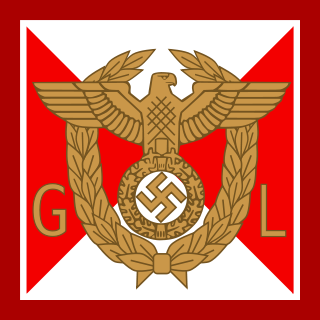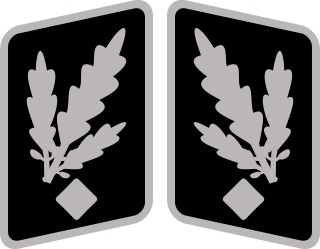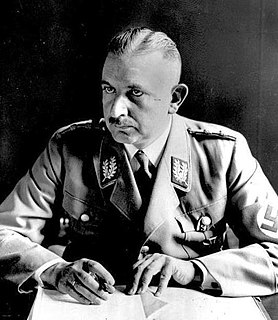
Wilhelm Frick was a prominent German politician of the Nazi Party (NSDAP), who served as Reich Minister of the Interior in Adolf Hitler's cabinet from 1933 to 1943 and as the last governor of the Protectorate of Bohemia and Moravia.
Führer is a German word meaning "leader" or "guide". As a political title it is associated with the Nazi dictator Adolf Hitler.

A Gauleiter was a regional leader of the Nazi Party (NSDAP) who served as the head of a Gau or Reichsgau. Gauleiter was the third-highest rank in the Nazi political leadership, subordinate only to Reichsleiter and to the Führer himself. The position was effectively abolished with the fall of the Nazi regime on 8 May 1945.

Gruppenführer was an early paramilitary rank of the Nazi Party (NSDAP), first created in 1925 as a senior rank of the SA. Since then, the term Gruppenführer is also used for leaders of groups/teams of the police, fire departments, military and several other organizations.
This is a list of words, terms, concepts and slogans of Nazi Germany used in the historiography covering the Nazi regime. Some words were coined by Adolf Hitler and other Nazi Party members. Other words and concepts were borrowed and appropriated, and other terms were already in use during the Weimar Republic. Finally, some are taken from Germany's cultural tradition.

The Hitler cabinet was the government of Nazi Germany between 30 January 1933 and 30 April 1945 upon the appointment of Adolf Hitler as Chancellor of the German Reich by president Paul von Hindenburg. It was originally contrived by the national conservative politician Franz von Papen, who reserved the office of the Vice-Chancellor for himself. Originally, Hitler's first cabinet was called the Reich Cabinet of National Salvation, which was a coalition of the Nazi Party (NSDAP) and the national conservative German National People's Party (DNVP).

Hauptsturmführer was a Nazi Party paramilitary rank that was used in several Nazi organizations such as the SS, NSKK and the NSFK. The rank of Hauptsturmführer was a mid-level commander and had equivalent seniority to a captain (Hauptmann) in the German Army and also the equivalency of captain in foreign armies.

The uniforms and insignia of the Sturmabteilung (SA) were Nazi Party paramilitary ranks and uniforms used by SA stormtroopers from 1921 until the fall of Nazi Germany in 1945. The titles and phrases used by the SA were the basis for paramilitary titles used by several other Nazi paramilitary groups, among them the Schutzstaffel (SS). Early SS ranks were identical to the SA, since the SS was originally considered a sub-organization of the Sturmabteilung.

Blockleiter, where block refers to city block, was from 1933 the title of a lower Nazi Party political rank responsible for the political supervision of a neighborhood. Referred to in common parlance as Blockwart, the Block Warden's duty was to form the primary link between the Nazi authorities and the general population. The derogatory term Blockwart ("snoop") survives in German colloquial language.

Ranks and insignia of the Nazi Party were paramilitary titles used by the National Socialist German Workers' Party (NSDAP) between approximately 1928 and the fall of Nazi Germany in 1945. Such ranks were held within the political leadership corps of the Nazi Party, charged with the overseeing of the regular Nazi Party members.

Franz Xaver Schwarz was a high ranking German Nazi Party official who served as Reichsschatzmeister of the Party throughout most of its existence. He was also one of the highest ranking members of the Schutzstaffel (SS).
Zellenleiter was a Nazi Party political title which existed between the years of 1930 and 1945. A Zellenleiter was higher in rank than a Blockleiter and was in charge of a "Nazi Cell", composed of eight to twelve city blocks.
Abteilungsleiter, German for department head, was also a mid-level administrative political position of the Nazi Party, often held by staff political officers attached to various Gaue throughout Germany. The position of Abteilungsleiter was not an actual Nazi Party political rank, but a title held by a Party member in addition to their formal rank. The position was first created in 1933, after the Nazis had secured power in Germany.

Ortsgruppenleiter was a Nazi Party political rank and title which existed between 1930 and 1945. The term first came into being during the German elections of 1930, and was held by the head Nazi of a town or city, or in larger cities, of a neighbourhood, for the purposes of election district organization. After 1933, through the process of Gleichschaltung, the position of Ortsgruppenleiter evolved into the Nazi leader of a large town or city or of a city district.

Kreisleiter was a Nazi Party political rank and title which existed as a political rank between 1930 and 1945 and as a Nazi Party title from as early as 1928. The position of Kreisleiter was first formed to provide German election district coordination and, after the Nazi assumption of power, the position became one of county municipal government, effectively replacing the traditional German government establishment.

Dienstleiter was a high-ranking Nazi Party political rank of Nazi Germany which existed between 1933 and 1945. The rank was first created after the Nazi assumption of power and served as the second highest rank of the Reichsleitung Nazi Party organizational level, subordinate to the Reichsleiter.
Mitarbeiter, German for "Work Colleague" was also a Nazi Party political rank and title which existed between 1933 and 1945. As a political rank, Mitarbeiter was created in 1933 after the Nazis came to power in Germany. Considered the lowest political rank, Mitarbeiter replaced the older rank of Blockleiter and was also used as an administrative staff rank on the Kreis (County), Gau (Region), and Reich (National) Party Levels.
Arbeitsleiter, German for work leader, was also a Nazi Party political rank which existed between 1939 and 1945. The rank was created to replace the former rank of mitarbeiter and was divided into three levels of arbeitsleiter, oberarbeitsleiter, and hauptarbeitsleiter.

Stellenleiter was a Nazi Party political rank which existed between 1933 and 1938. The rank was created as a mid-level political position intended to replace the older rank of Zellenwart, also known as Zellenleiter. In the early Nazi Party rank organization, the position of Stellenleiter was senior to Mitarbeiter and junior to Amtsleiter.

Gemeinschaftsleiter was a Nazi Party political rank which existed between 1939 and 1945. Created primary to replace the older rank of Stützpunktleiter, the rank of Gemeinschaftsleiter was often used on the local level of the Nazi Party to denote the second in command of a municipal region, answering to a regional Nazi known by the title of Ortsgruppenleiter.














